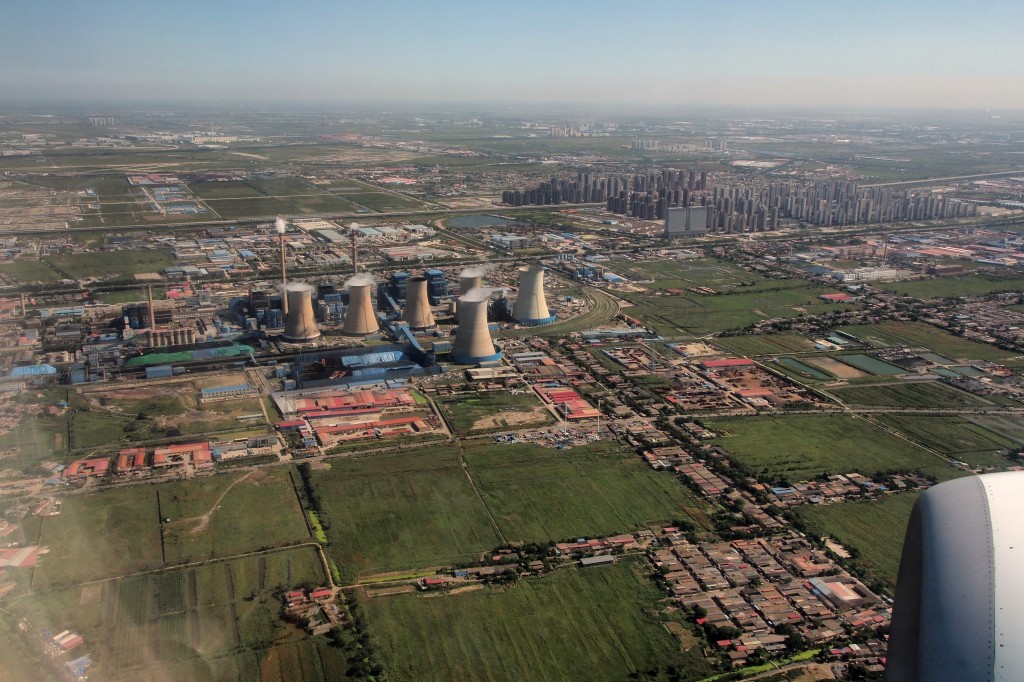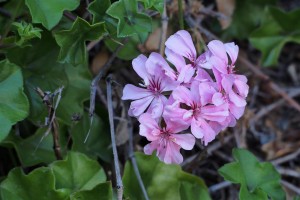 Well, it’s the end of August. The back-yard geraniums that had bloomed in June when I arrived now are blooming again to commemorate my imminent departure on Saturday, Sept 6.
Well, it’s the end of August. The back-yard geraniums that had bloomed in June when I arrived now are blooming again to commemorate my imminent departure on Saturday, Sept 6.
Time to migrate to the East. It’s been an odd summer. As many know, my feet all but broke down completely, so I didn’t do much. Just didn’t feel like standing up, let alone getting out. On the other hand, between two physical therapists and one podiatrist, I have a plan to regain my walking abilities. So far it’s working. My hope is that by December I will once again be circling the Tianjin University campus, as I often did with my friend Jeanne, which also yielded many of the photos that I’ve included in these messages over the last few months.
Before I depart, I would like to post a few more pictures of America, particularly for those overseas who wonder what there is to do in America without having to walk too much! County Fairs are not the only things happening!
Roll on, Columbia
I spent a wonderful two weeks in Portland, visiting my mother and sister and some foot specialists.
Portland, of course, is situated at the end of the Columbia gorge, a gigantic canyon filled with the Columbia River, one of the largest rivers on America’s western end.
 The roads ascend the cliffs, and follow them along. Close-passing logging trucks proved a bit hair raising in their speed, weight, and width. Well, maybe walking along the road at that location was not the wisest idea. It reminded me of my father telling me of his adventurous youth, piloting such trucks through some of the nearby forests, and how a fully-loaded logging truck (like the one in the picture) is not easy to stop. They also kick up quite a breeze when they pass by your ear.
The roads ascend the cliffs, and follow them along. Close-passing logging trucks proved a bit hair raising in their speed, weight, and width. Well, maybe walking along the road at that location was not the wisest idea. It reminded me of my father telling me of his adventurous youth, piloting such trucks through some of the nearby forests, and how a fully-loaded logging truck (like the one in the picture) is not easy to stop. They also kick up quite a breeze when they pass by your ear.
 The Columbia River, because of the steep cliffs, is a great place to build a dam. In fact, there are about a dozen dams along it, and another two dozen on its major tributaries. Unlike the situation in California, water is not stored to assuage the thirst of the land. In Western Oregon, it rains all the time!! Instead, the dams mainly generate electricity. And in fact, about two-thirds of all electricity in that part of the country comes from dams.
The Columbia River, because of the steep cliffs, is a great place to build a dam. In fact, there are about a dozen dams along it, and another two dozen on its major tributaries. Unlike the situation in California, water is not stored to assuage the thirst of the land. In Western Oregon, it rains all the time!! Instead, the dams mainly generate electricity. And in fact, about two-thirds of all electricity in that part of the country comes from dams.
The Bonneville Dam
The dam pictured above is the Bonneville Dam, the closest one to Portland. It’s actually a dam complex. The picture shows the high-tension electrical wires. The closest white water in the river is the entrance to a “fish ladder” that allows migrating fish to pass through the dam to their spawning grounds upriver. I still remember coming here as a kid to see the fish climbing the ladder.
 And in fact, we stopped to watch the ladder-climbing fish. And there’s even a viewing chamber with a glass wall in the side of the ladder to see them close up. And as shown in this picture, I’m not the only one who goes wild with a camera at times like these.
And in fact, we stopped to watch the ladder-climbing fish. And there’s even a viewing chamber with a glass wall in the side of the ladder to see them close up. And as shown in this picture, I’m not the only one who goes wild with a camera at times like these.
Most of the fish were salmon, of course, but we also saw many lampreys. Lampreys are the cutest fish this side of hagfish. They attach themselves to other fish with their sucker mouths. A ring of sharp teeth penetrates the fish’s scales and the lamprey feasts a la Dracula on the fish’s blood.
 Interestingly, lampreys also use these sucking mouth parts to glom onto the glass in the viewing chamber, to take a break in the swift-moving current, like the fish in the picture. It held onto the glass and let it’s long body wave “in the breeze” like a banner on a windy day. If you want to see the teeth, just click on the picture for the full-sized version.
Interestingly, lampreys also use these sucking mouth parts to glom onto the glass in the viewing chamber, to take a break in the swift-moving current, like the fish in the picture. It held onto the glass and let it’s long body wave “in the breeze” like a banner on a windy day. If you want to see the teeth, just click on the picture for the full-sized version.
And here are the actual electricity-producing  turbines. People on organized tours, in fact, are allowed to walk out onto one of them. If you look close you can see the bridge to it. Unfortunately, no groups were operating at the time we arrived, so we could only view them from the floor above. Without people in the picture, it’s hard to appreciate the scale of this apparatus. But luckily, somebody came riding across the floor on a giant tricycle when I snapped the picture.
turbines. People on organized tours, in fact, are allowed to walk out onto one of them. If you look close you can see the bridge to it. Unfortunately, no groups were operating at the time we arrived, so we could only view them from the floor above. Without people in the picture, it’s hard to appreciate the scale of this apparatus. But luckily, somebody came riding across the floor on a giant tricycle when I snapped the picture.
It was a lovely trip that day. Highlights not only included the dam and several impressive views, but also some new pajamas from the world-famous Pendleton mills, located on the Columbia’s Washington shore.
Powell’s Books
 And speaking of scale, for decades, I’ve been trying to snap a photo that truly represents the immensity of Powell’s main bookstore on Burnside. I don’t really think it’s possible, though. My favorite picture so far shows just the corner of the building. I snapped it on a cool winter’s evening a few months ago. Powell’s was an early adopter of the coffee-browsing bookstore culture. The thought of that warm coffee just on the other side of the glass wall was overwhelming on that chilly evening.
And speaking of scale, for decades, I’ve been trying to snap a photo that truly represents the immensity of Powell’s main bookstore on Burnside. I don’t really think it’s possible, though. My favorite picture so far shows just the corner of the building. I snapped it on a cool winter’s evening a few months ago. Powell’s was an early adopter of the coffee-browsing bookstore culture. The thought of that warm coffee just on the other side of the glass wall was overwhelming on that chilly evening.
 This summer, I snapped a photo from the other side of the building. The size is more apparent in this shot, but there’s little warmth in the composition.
This summer, I snapped a photo from the other side of the building. The size is more apparent in this shot, but there’s little warmth in the composition.
Pictures taken inside also fail to demonstrate the size — the books are stacked so thick and tall that a photographer can hardly step back far enough to view more than a case at a time, except at the staircases or through the windows. Here are some examples.


 Anyway, Powell’s Books is still one of the great independent booksellers. Book lovers should heed the call if they’re headed towards the Northwest.
Anyway, Powell’s Books is still one of the great independent booksellers. Book lovers should heed the call if they’re headed towards the Northwest.
Rock and Roll
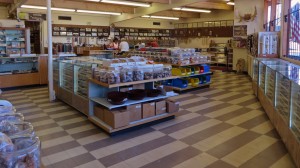 Only a few blocks from our residence in Portland stands Ed’s House of Gems. For people who like rocks, fossils, and shells, it’s like a museum where everything is for sale.
Only a few blocks from our residence in Portland stands Ed’s House of Gems. For people who like rocks, fossils, and shells, it’s like a museum where everything is for sale.
It’s stood at that location since before I was old enough to remember. Ed’s furnished the Nautilus shell that I used in class for many years. It’s where I bought a Jurassic-Park-like piece of amber with insects inside. And let’s not forget the trilobites.
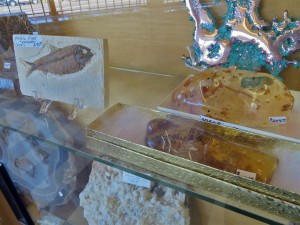
 They have rocks in every stage of finishing – from just dug out, to polished to a high sheen, to mounted as earrings and brooches. And also every stage from cheap to expensive. It’s really a wonderful variety in all respects. Since I was a kid, they also added a back room, lockable at night, full of their most unusual items.
They have rocks in every stage of finishing – from just dug out, to polished to a high sheen, to mounted as earrings and brooches. And also every stage from cheap to expensive. It’s really a wonderful variety in all respects. Since I was a kid, they also added a back room, lockable at night, full of their most unusual items.
 I can’t say enough good things about them, and I don’t even work for them. Well, they deserve all the free advertizing they can get. If anybody from overseas (or underseas) ever comes to visit us in Portland, plan on a trip to Powell’s and to Ed’s.
I can’t say enough good things about them, and I don’t even work for them. Well, they deserve all the free advertizing they can get. If anybody from overseas (or underseas) ever comes to visit us in Portland, plan on a trip to Powell’s and to Ed’s.
Bay Area Highlights
And actually, I did have an overseas visitor in the Bay Area this summer — one of that group of Tianjin journalists which I’ve been so lucky to know over the years. She was here in the Bay Area for only three days, but we really took in a lot.
 And I had a newly-purchased telephoto lens to try out. Here, for example, is an American Great Egret, caught stalking fish (and catching them) on San Francisco Bay.
And I had a newly-purchased telephoto lens to try out. Here, for example, is an American Great Egret, caught stalking fish (and catching them) on San Francisco Bay.
Despite my having taught elementary school for so many decades, it was my first trip to Crab Cove in Alameda, a place full of crabs and the creatures who consume them.
 Some of the birds, like this egret, can be seen all year round. Others, like this group of Pacific Golden Plover, I was lucky to spot as they wended their way by on their annual migration.
Some of the birds, like this egret, can be seen all year round. Others, like this group of Pacific Golden Plover, I was lucky to spot as they wended their way by on their annual migration.
Anyway, besides the birds, there were plenty of invertebrates, from crustaceans to worms, as well as a double-helping of ground squirrels, who climbed right onto the picnic table to snatch the food given to us by our neighbors up the street the previous evening.
 The squirrels who attacked our table were considerably fatter than the lean one in this picture. I didn’t think they deserved a picture, however.
The squirrels who attacked our table were considerably fatter than the lean one in this picture. I didn’t think they deserved a picture, however.
Anyway, there’s also a visitor center with living fish exhibits. I can see why so many elementary school classes have visited there over the years.
 We also took in the Oakland Museum. It has three levels for art, nature, and history.
We also took in the Oakland Museum. It has three levels for art, nature, and history.
And I have to say, it’s odd to visit a history museum and see exhibits of items that I remember from real life, such as the Doggie Diner sign in the section on California Car Culture.
 We also stopped by Fenton’s in Oakland for the East Bay’s premier ice cream experience. Amazingly, and probably for the first time since I was in high school, I found a parking space in their tiny lot.
We also stopped by Fenton’s in Oakland for the East Bay’s premier ice cream experience. Amazingly, and probably for the first time since I was in high school, I found a parking space in their tiny lot.
Yeah, I did take a picture of the ice cream itself, but there’s no need to torture the readers of this message with the image of an item that they can’t reach.
Did we ever get to San Fr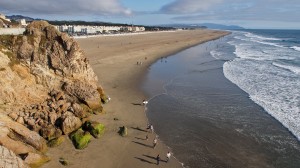 ancisco? Yes, and the highlight was the beach, Ocean Beach, south of Cliff House.
ancisco? Yes, and the highlight was the beach, Ocean Beach, south of Cliff House.
The naturalists among you would have noticed a shoal of Vellela Vella, also known as “By-the-wind-sailors” which had washed ashore.
 I was able to drop into “docent mode” and explain these little creatures to some passers-by. What looks like an individual animal is actually a colony of tiny anemone-like creatures, similar to the Portuguese Man-o-war, but not dangerous. The sail is constructed by specialized members of the colony, and it does indeed catch the wind, enabling the entire colony to move about the ocean’s surface to reach new food sources. Usually, they’re found far out at sea, but this time, the wind had blown them onto shore.
I was able to drop into “docent mode” and explain these little creatures to some passers-by. What looks like an individual animal is actually a colony of tiny anemone-like creatures, similar to the Portuguese Man-o-war, but not dangerous. The sail is constructed by specialized members of the colony, and it does indeed catch the wind, enabling the entire colony to move about the ocean’s surface to reach new food sources. Usually, they’re found far out at sea, but this time, the wind had blown them onto shore.
 We also visited other parts of Golden Gate Park, including the AIDS memorial garden, and the Japanese Garden. I was disappointed to find, though, that the arboretum, formerly free and open, now charges a rather expensive entrance fee.
We also visited other parts of Golden Gate Park, including the AIDS memorial garden, and the Japanese Garden. I was disappointed to find, though, that the arboretum, formerly free and open, now charges a rather expensive entrance fee.
And speaking of that, I discovered that there are no longer any toll-takers on the Golden Gate bridge! If you don’t have the electronic payment system on your car, then it snaps a picture of your license plate, and you get the bill in the mail a couple weeks later. And it’s $7.
 Did we ever get to Chinatown? Yeah, but not to the San Francisco version. We actually tried to get there, but it’s simply too difficult to negotiate that neighborhood in a car, let alone find a place to park, let alone one that doesn’t cost an arm or a leg.
Did we ever get to Chinatown? Yeah, but not to the San Francisco version. We actually tried to get there, but it’s simply too difficult to negotiate that neighborhood in a car, let alone find a place to park, let alone one that doesn’t cost an arm or a leg.
So we visited the Chinatown in Oakland, instead. Arguably, it was a better choice anyway, because it’s not so tourist-oriented. What you see are ordinary people leading normal lives. And the traffic is a little bit heavy, but not bad, and parking was easy to find, too.
 The final stop was the Lawrence Hall of Science in Berkeley, for that magnificent view of almost the entire bay, framed by fog falling through the hills from the outer coast. Again, those with quick Internet connections can click the panorama and enjoy the view for themselves.
The final stop was the Lawrence Hall of Science in Berkeley, for that magnificent view of almost the entire bay, framed by fog falling through the hills from the outer coast. Again, those with quick Internet connections can click the panorama and enjoy the view for themselves.
 The final shot for this post is a shot of Castro Valley’s beloved Lake Chabot, taken from a slightly unusual vantage point, the trail along the top of the hills, which my feet have healed enough to enable me to reach for the first time this summer. My friends the Smiths call it the “dog path,” because dogs can be walked off leash. Indeed, most of the strollers I encountered had dogs with them, and all of them were friendly.
The final shot for this post is a shot of Castro Valley’s beloved Lake Chabot, taken from a slightly unusual vantage point, the trail along the top of the hills, which my feet have healed enough to enable me to reach for the first time this summer. My friends the Smiths call it the “dog path,” because dogs can be walked off leash. Indeed, most of the strollers I encountered had dogs with them, and all of them were friendly.




